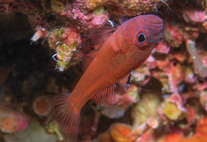Abstract
Three new species of the gobiid Trimma are described from Indonesian waters, and a partially reformulated nomenclature for the cephalic sensory papillae of members of this genus is provided. Trimma aturirii possesses two dark oblique stripes on either side of the pupil (blue, edged with red in life, dark brown in preservative), the lower of which continues posteriorly across the dorsal margin of the opercle, with the dorsal half of the body red and the ventral half abruptly white in life. The species has a narrow bony interorbital (≤50% pupil width), a moderate interorbital trench with a slight groove posterodorsal to the eye, no scales on the cheek, opercle or in the predorsal midline, no elongate spines in the first dorsal fin, 9–10 dorsal and 9 anal fin rays, 17–18 (7–11 branched) pectoral fin rays and an unbranched fifth pelvic fin ray. Trimma kardium has a pair of tapering oval red spots which join anteriorly over the anterior region of the hyoid arches, forming an approximate heart-shaped marking on the ventral surface of the head. It has a narrow bony interorbital (≤40% pupil width), a moderate interorbital trench with a slight groove posterodorsal to the eye, 17–18 unbranched pectoral fin rays, 1–5 cycloid scales in the predorsal midline confined to about the middle third of the nape, and a single row of 1–3 cycloid scales along the upper border of the opercle. Trimma trioculatum has a large (slightly greater than pupil diameter in width) round, black, ocellated spot in the first dorsal fin between spines 1 and 5, a second, much smaller black or dark red spot just posterior to the spine of the second dorsal fin and above the basal stripe, a yellow body with a dark purplish or gray head with two distinct red bars across the cheek, no round spots of any colour on the nape, opercle or cheek, a small dark (preserved) or white (alive) spot on the upper pectoral fin base, a narrow bony interorbital (<70% pupil diameter), no elongate spines in the first dorsal fin, 15–16 pectoral fin rays with the middle 4–8 rays branched, a fifth pelvic fin ray with a single dichotomous branch, and 16–17 total gill rakers on the first gill arch.

